

Examples of Expressionist works:
Listed
chronologically by artist's birth year
Use ctrl-F (PC) or command-F (Mac) to search for a name
Antonio Gaudi (Spanish, 1852-1926), Sagrada Familia (Church of the Holy Family), masonry, not completed during Gaudi's lifetime and not completed today, though construction continues. The style of this architect's work is expressionistic.
![]()
James Ensor (Belgian, 1860-1949), Christ's Entry into Brussels in 1889,
1888, oil on canvas,
99 1/2 x 169 1/2 inches (252.5 x 430.5 cm), J. Paul Getty Museum,
Malibu, CA. Ensor was a forerunner of Expressionism and Surrealism.
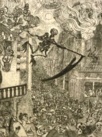
James Ensor, Death Chasing the Flock of Mortals, 1896,
drypoint and
etching, plate: 9 7/16 x 7 3/16 inches
(23.9 x 18.2 cm), Museum of Modern Art, NY.
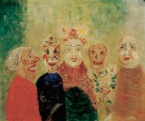
James Ensor, Marriage des masques (Marriage of the Masks),
1910, oil on canvas,
50.5 x 61 cm.
Edvard Munch (Norwegian, 1863-1944) The Scream, 1893, oil and tempera on board, National Gallery, Oslo.

Edvard Munch, The Storm (Storm), 1893, oil on canvas, 36 1/8 x 51 1/2 inches (91.8 x 130.8 cm), Museum of Modern Art, NY.

Edvard Munch, Madonna, 1895-1902, lithograph and woodcut, complete: 23 3/4 x 17 1/2 inches
(60.5 x 44.5 cm), edition: c. 250, Museum of Modern Art, NY.
This was exhibited in the Armory
Show of 1913. See Madonna
and Symbolism.

Edvard Munch, Count Harry Kessler, 1906, oil
on canvas, Neue Nationalgalerie,
Berlin. Harry Kessler was a German patron of avant-garde
art and design who died in 1937. See portrait.

Edvard Munch, The Sick Child, 1907, oil
on canvas, 118.7 x 121.0
cm, Tate Gallery, London.
Käthe Kollwitz (German, 1867-1945), Selbstibildnis am Tisch, II. Fassung (Self-Portrait at the Table, Second Version), c. 1893, etching and aquatint, image 18 x 12.6 cm; sheet 45 x 31.5 cm, Fine Arts Museums of San Francisco, CA. See feminism and feminist art, German art, and self-portrait.
Käthe Kollwitz, Ende (End), from the series, A Weavers' Rebellion, 1898, mixed intaglio methods, 245 x 305 mm, Spencer Museum, KS. Click here for a 77 k image.
Käthe Kollwitz, Selbstbildnis mit der Hand an der Stirn (Self-Portrait with Hand on the Forehead), 1910, etching, plate 15.5 x 13.8 cm, Fine Arts Museums of San Francisco, CA.
Käthe Kollwitz, Kleines Selbstbildnis (Small Self-Portrait), 1920, lithograph, sheet 32.4 x 24 cm; image 23.5 x 20 cm, Fine Arts Museums of San Francisco, CA.
Käthe Kollwitz, Selbstbildnis (Self-Portrait), 1921, etching on paper, plate 8 1/2 x 10 1/2 inches (21.7 x 26.8 cm), National Museum of Women in the Arts, Washington, DC.
Käthe Kollwitz, Kleines Selbstbildnis nach links (Small Self-Portrait from the left) (2nd version), 1922, lithograph, image 19 x 12.5 cm; sheet 34.6 x 25 cm, Fine Arts Museums of San Francisco, CA.
Käthe Kollwitz, Selbstbildnis von vorn (Self-Portrait from the Front), 1923, woodcut, image 15 x 15.6 cm, Fine Arts Museums of San Francisco, CA.
Käthe Kollwitz, Selbstbildnis im Profil nach Rechts (Self-Portrait in Profile to the Right), 1938, lithograph, image 47.9 x 29.4 cm; sheet 65.1 x 49.2 cm, Fine Arts Museums of San Francisco, CA.
Emil Nolde (German, 1867-1956), E.N. (Selbstporträt) (E. N. (Self-Portrait)), 1908, etching with tonal effects on iron, image 30.8 x 23.5 cm, printer, Otto Felsing, Fine Arts Museums of San Francisco, CA. See Die Brücke and self-portrait.
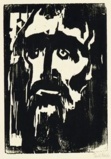
Emil Nolde (German, 1867-1956), Prophet, 1912, woodcut,
edition of 20-30, 12 5/8
x 8 3/4 inches (32.1 x 22.2 cm), Museum of Modern Art, NY.

Emil Nolde, The Three Kings, 1913,
color lithograph,
24 1/4 x 21 inches (64.5 x 53.6 cm), Cincinnati Art Museum, OH.
See Expressionism.
Ernst Barlach (German, 1870-1938). Also see degenerate.

Georges Rouault (French, 1871-1958), Slaughter, 1905, watercolor, gouache and India
ink on paper, 52 x 66.3 cm,
Georges Pompidou Center, Paris.
Georges Rouault, Woman at a Mirror, 1906, watercolor on cardboard, 70 x 55.5 cm, Georges Pompidou Center, Paris.

Georges Rouault, Parade, c. 1907-1910, watercolor and oil
on paper mounted
on canvas, 65 x 100 cm,
Georges Pompidou Center, Paris.

Georges Rouault, Nude Back, 1910, oil
on paper mounted
on canvas, 72 x 57 cm,
Georges Pompidou Center, Paris. See nude.

Georges Rouault, The Crucifixion, 1920-1925, multimedia
on paper and canvas,
39 1/2 x 29 1/2 inches, Minneapolis Institute of Arts.
Georges Rouault, Self-Portrait, c. 1928, color lithograph, image 34.9 x 24.8 cm; sheet 56.2 x 41.7 cm, Fine Arts Museums of San Francisco, CA.

Georges Rouault, Pierrot Reclining, 1932, oil
on paper mounted
on canvas, 65 x 100 cm,
Georges Pompidou Center, Paris.

Paula Modersohn-Becker (German, 1876-1907),
Self-Portrait, Half-Figure with Amber Necklace
II (Selbstbildnis als Halbakt mit Bernsteinkette II),
Summer of 1906, oil on
canvas, 61 x 50 cm, Kunstmuseum,
Basel, Switzerland. See feminism
and feminist art.

Marsden Hartley (American, 1877-1943), Portrait of a German Officer, 1914, oil on canvas,
68 1/4 x 41 3/8 inches (173.4 x 105.1 cm), Metropolitan Museum
of Art, NY.
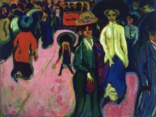
Ernst Ludwig Kirchner (German, 1880-1938), Street, Dresden, 1908 (dated on painting 1907), oil on canvas, 59 1/4 inches x 6 feet 6 7/8 inches (150.5 x 200.4 cm), Museum of Modern Art, NY.

Ernst Ludwig Kirchner,
Bathers at Moritzburgm, 1909 / 26, oil on canvas,
151.1 x 199.7 cm, Tate Gallery, London. See Die
Brücke.

Ernst Ludwig Kirchner, Bathers Throwing Reeds, from the portfolio
Brücke V, 1909-10, woodcut, complete: 7 7/8 x 11 1/2 inches
(20 x 29.2 cm). Publisher: Künstlergruppe Brücke, Dresden; edition: c. 68.

Ernst Ludwig Kirchner, Seated Woman, 1910-1920, oil
on canvas, 35 7/8 x 31
3/4 inches, Minneapolis Institute of Arts.

Ernst Ludwig Kirchner, The Belle-Alliance-Platz in Berlin, 1914,
oil on canvas,
200 x 150 cm, Neue Nationalgalerie, Berlin.

Ernst Ludwig Kirchner, Dresden: Schlossplatz, 1926, oil
on canvas, 47 1/4 x 59
inches, Minneapolis Institute of Arts.

Ernst Ludwig Kirchner, Bern with Belltower, 1935, oil
on canvas, 27 3/4 x 31
3/4 inches, Minneapolis Institute of Arts.
Max Pechstein (German, 1881-1955), Early Morning, 1914, oil on canvas, 32 1/4 x 39 3/4 inches, Portland Art Museum, ME. See secession.
Max Pechstein, Selbstbildnis mit Pfeife (Raucher) (Self-Portrait with Pipe (Smoker)), from Die Schaffenden (Weimar, 1924), 1921, woodcut, image 34 x 28 cm, Fine Arts Museums of San Francisco, CA. See self-portrait.
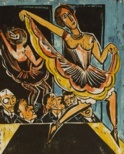
Max Pechstein, Dancer Reflected in a Mirror, 1923, woodcut,
edition of 51, 19 9/19
x 15 3/4 inches (49.6 x 40 cm), Museum of Modern Art, NY. Publisher:
Euphorian Verlag, Berlin. See mirror.

Erich Heckel (German, 1883-1970), Bildnis E.H. (Self-Portrait), 1917, woodcut,
image 36.4 x 29.5 cm; sheet 61.6 x 50.7 cm, Fine Arts Museums
of San Francisco, CA. See Die Brücke and self-portrait.

Max Beckmann (German, 1884-1950), The Feast of the Prodigal Son, 1918, gouache and pencil on parchment, 14 1/4 x 11 3/4 inches (36.1 x 29.7 cm), Museum of Modern Art, NY.

Max Beckmann, Carnival (Fastnacht), 1920, oil
on canvas, 186.4 x 91.8
cm, Tate Gallery, London.

Max Beckmann, The Skaters, 1932, oil
on canvas, 50 1/2 x 38
1/2 inches, Minneapolis Institute of Arts.

Max Beckmann, Beginning, 1949, oil
on canvas, 69 x 125 1/2
inches (175.3 x 318.8 cm), Metropolitan Museum of Art, NY.

Karl Schmidt-Rottluff (German, 1884-1976),
Two Women, 1912, oil
on canvas, 76.5 x 84.5
cm, Tate Gallery, London. See Die Brücke.

Karl Schmidt-Rottluff, Pharisees, 1912, oil on canvas, 29 7/8 x 40 1/2 inches (75.9 x 102.9 cm), Museum of Modern Art, NY.
Karl Schmidt-Rottluff, Selbstbildnis (Self-Portrait), 1914, woodcut, image 34.9 x 29.7 cm; sheet 57.8 x 45.1 cm, Fine Arts Museums of San Francisco, CA. See self-portrait.

Karl Schmidt-Rottluff, Woman with a Bag, 1915, oil
on canvas, 95.2 x 87.3
cm, Tate Gallery, London.
![]()

Karl Schmidt-Rottluff, Male Head, 1917, wood,
34.3 x 13.3 x 16.5 cm, Tate Gallery, London.

Karl Schmidt-Rottluff, Dr. Rosa Schapire, 1919, oil
on canvas, 100.6 x 87.3
cm, Tate Gallery, London.
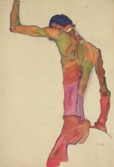
Egon Schiele (Austrian, 1890-1918), Standing Male Nude with Arm Raised, 1910, watercolor and charcoal on paper, 17 1/2 x 12 1/4 inches (44.5 x 30.8 cm), Museum of Modern Art, NY.

Egon Schiele, Girl with Black Hair, 1911, watercolor and pencil on paper, 22 1/8 x 14 1/2 inches (56.2 x 36.7 cm), Museum of Modern Art, NY.

Egon Schiele, Seated Woman, Back View, 1917, watercolor, gouache and pencil
on paper, 18 1/4 x 11 3/4 inches
(46.4 x 29.8 cm), Metropolitan Museum of Art, NY.

Egon Schiele, Portrait of Paris von Gütersloh,
1918, oil on canvas,
55 1/8 x 43 7/16 inches, Minneapolis Institute of Arts. See portrait.

Otto Dix (German, 1891-1969), Erinnerung an die Spiegelsäle von Brüssel
(A Memory of the Glass House in Brussels), 1920, oil and glass on a sheet of silver on canvas,
124 x 80.4 cm, Georges Pompidou Center, Paris. This and other
works by German artists produced in the years following World
War I were called Die neue Sachlichkeit — translated
as "the new matter-of-factness," or "the new resignation,"
or even, "the new blah." Dix, George Grosz [below],
Georg Schotz, Otto Griebel, and Heinrich Maria Davringhausen
produced paintings of this kind, filled with images of such social
decay as prostitution, people maimed by war, corrupt government,
business and military leaders. Later, the Nazis included such
works among those they called degenerate
art. See Dada
and ugly.

Otto Dix, Self-Portrait, 1922, watercolor and pencil on paper, 19 3/8 x 15 1/2 inches (49.2 x 39.3 cm), Museum of Modern Art, NY. See self-portrait.
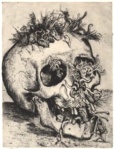
Otto Dix, Skull from the portfolio War, 1924, etching, impression: "39/70" lower left margin, pencil, artist's hand, Museum of Modern Art, NY.

Otto Dix, The Journalist Sylvia Von Harden, 1926,
oil and tempera
on wood, 121 x 89 cm, Georges Pompidou Center, Paris.

George Grosz (German, worked there and in
USA, 1893-1959), Suicide (Selbstmörder), 1916, oil on canvas,
100.0 x 77.5 cm, Tate Gallery, London.
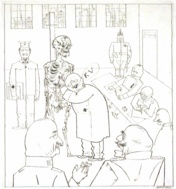
George Grosz, Fit for Active Service, 1918, ink on paper, 20 x 14 3/8 inches (50.8 x 36.5 cm), Museum of Modern Art, NY.
George Grosz, Remember Uncle August, the Unhappy Inventor, 1919, oil, pencil, paper and five buttons adhered to canvas, 49 x 39.5 cm, Georges Pompidou Center, Paris.
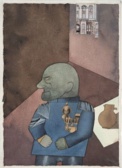
George Grosz, "The Convict": Monteur John Heartfield after Franz Jung's Attempt to Get Him Up on His Feet, 1920, watercolor, pencil, cut-and-pasted postcards, and halftone relief on paper, 16 1/2 x 12 inches (41.9 x 30.5 cm), Museum of Modern Art, NY.
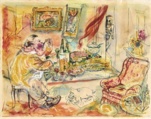
George Grosz, The Unexpected Guest, 1925, pen
and ink, watercolor, gouache on paper,
45.8 cm x 59.8 cm, Tehran Museum of Contemporary Art, Iran. See
grotesque.

George Grosz, Circe, 1927, watercolor, ink, and pencil on paper; sheet: 25 7/8 x 19 1/8 inches (65.7 x 48.6cm); frame: 34 1/2 x 27 inches (87.6 x 68.6 cm), Museum of Modern Art, NY.

George Grosz, A Married Couple, 1930, watercolor on paper,
66.0 x 47.3 cm, Tate Gallery, London.
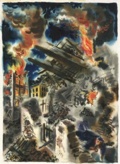
George Grosz, Punishment, 1934, watercolor on paper, 27 1/2 x 20 1/2 inches (69.8 x 52.1 cm), Museum of Modern Art, NY.
![]()
Chaïm Soutine (Russian-French, 1893/4-1943), Carcass of Beef, 1926, oil
on canvas, 45 3/4 x 31
3/4 inches, Minneapolis Institute of Arts. See Jewish art.
Also see degenerate, expressionism, expressive qualities, and isms and -ism.
https://inform.quest/_art
Copyright © 1996-![]()